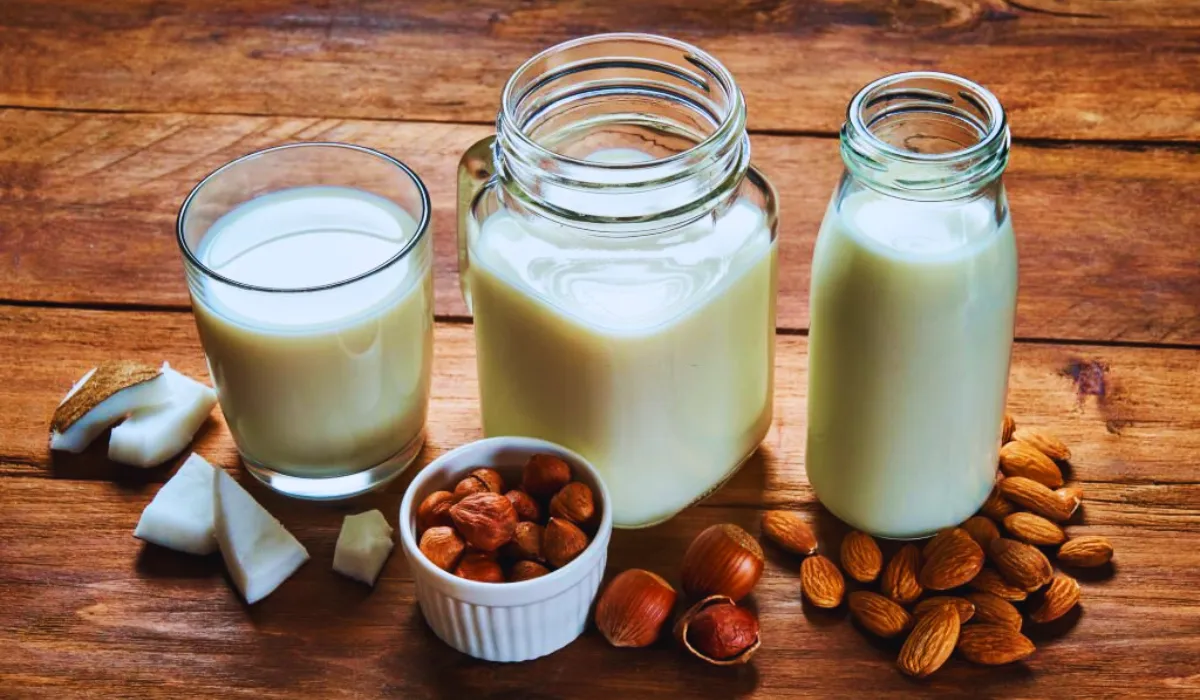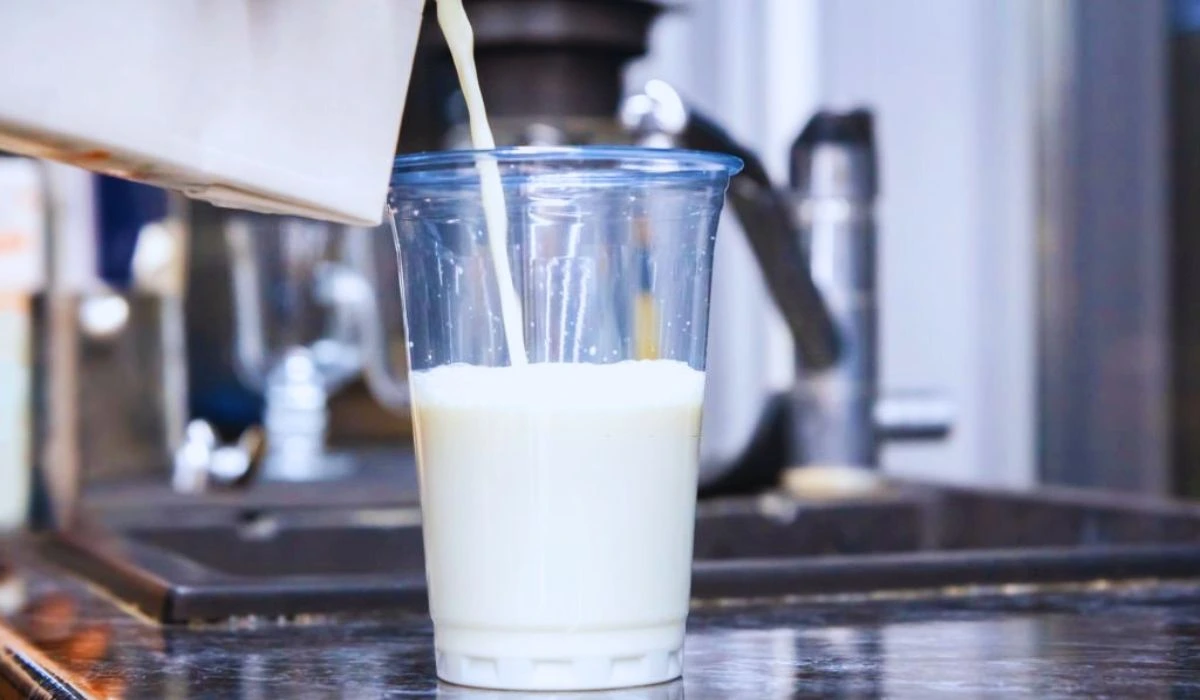Lactose intolerance is a common condition where people lack the enzyme lactase to properly digest lactose, the natural sugar found in milk and dairy products. This leads to gastrointestinal symptoms like bloating, gas, abdominal pain, and diarrhea after consuming lactose.
For lactose intolerant individuals, switching to lactose-free milk is an easy way to avoid these unpleasant symptoms while still getting the nutrition from dairy. There are several types of lactose-free milk available to meet different needs and preferences.
Importance Of Lactose-Free Milk And Different Types Of Them

🔹 Lactose-Free Cow’s Milk
This is regular cow’s milk that has had the lactose removed. The lactose is broken down into simple sugars glucose and galactose using the enzyme lactase. Lactose-free cow’s milk is nutritionally identical to regular milk, providing the same amounts of protein, fat, vitamins, and minerals. The only difference is it doesn’t contain lactose. This makes it a good option for those who like the taste and nutritional profile of cow’s milk but need to avoid lactose.
🔹 Lactose-Free Fortified Plant-Based Milk
With the rise in plant-based diets and veganism, there is more fortified non-dairy milk made from plants like soy, almond, oat, coconut, or rice. These plant milk are naturally lactose-free as they come from plants instead of cows.
Many are also enriched with vitamins and minerals like calcium to provide a nutritional profile closer to cow’s milk. Those with multiple food sensitivities can often tolerate these well.
🔹 Raw Milk
Raw milk comes straight from the cow and does not undergo the high-heat pasteurization process that destroys enzymes like lactase. This means some of the lactase remains intact in raw milk, making it easier to digest for some lactose-intolerant people. However, raw milk also poses a higher risk of contamination so it’s not recommended for everyone.
🔹 Goat’s Milk
Goat’s milk contains slightly less lactose than cow’s milk, with about 10-13g lactose per 8 oz cup compared to 12-13g. This may make it easier to tolerate for some people sensitive to lactose. The proteins and fats in goat’s milk are also different than cow’s milk so some find it easier to digest.
🔹 A2 Milk
A2 milk comes from cows that naturally produce only the A2 type of beta-casein protein rather than the more common A1 protein. Researchers believe A1 proteins may contribute to dairy intolerance. As A2 milk lacks A1 proteins, some people find it does not cause discomfort or other symptoms linked to typical cow’s milk.
Providing lactose-free options allows more people to get the health and nutritional benefits associated with milk consumption. Milk provides high-quality protein, calcium, vitamin D, vitamin B12, potassium, phosphorus, and other important nutrients. While plants like spinach and kale contain calcium, the calcium in dairy milk is more bioavailable and better absorbed. The vitamins and minerals in dairy milk also help build and maintain bones and teeth.
Also Check: 5 Foods That Can Cause Diarrhea – Think Twice Before Eating These!
Lactose-Free Milk Benefits

✅ Allows Lactose Intolerant People to Consume Dairy: The main benefit of lactose-free milk is it allows those with lactose intolerance to enjoy dairy products. When lactose is removed, people don’t suffer uncomfortable symptoms like bloating, gas, and diarrhea.
✅ Good Source of Protein: Dairy milk is an excellent source of protein, providing 8g per cup. Whey and casein, the two proteins in milk, are high-quality proteins containing all the essential amino acids. Protein is important for building and repairing muscle tissue.
✅ Rich in Calcium and Vitamin D: Calcium and vitamin D are critical nutrients needed for proper bone health. Just one cup of milk contains 300mg of calcium and 100 IU of vitamin D. Consuming low-fat dairy is linked to a reduced risk of osteoporosis.
✅ Healthy Source of Fat: While whole milk has significant saturated fat, low-fat and skim milk provides mostly unsaturated fats. These are the healthier fats that can help improve cholesterol levels. Dairy fat also contains conjugated linoleic acid, a type of fat that may promote fat burning.
✅ Nutrient Dense Food: Milk contains a range of important vitamins and minerals like vitamin A, vitamin B12, potassium, phosphorus, and selenium. Combined with protein, milk is one of the most naturally nutrient-rich foods.
✅ May Benefit Heart Health: Some research indicates dairy fat may reduce the risk of stroke and heart disease. Minerals like magnesium and calcium support healthy blood pressure too.
✅ Linked to Lower Body Weight: Consuming dairy, especially yogurt, has been associated with lower body fat and reduced risk of obesity. The protein and nutrients may support a healthy metabolism.
Lactose-Free Milk Side Effects
- Higher Cost: Lactose-free milk is typically more expensive than regular milk. Lactose-free versions can cost up to $1-3 more per half gallon. The enzymes used to remove the lactose increase the production costs.
- Lower Calcium Absorption: The lactose in regular milk may help improve calcium absorption. One study found lactose-free milk resulted in 22% less calcium absorption compared to regular milk. However, lactose-free milk still provides high calcium levels.
- Contains Trace Amounts of Lactose: No milk can be 100% lactose-free. While labeled “lactose-free”, this milk generally contains less than 0.1% lactose. Those extremely sensitive may still experience discomfort from trace amounts.
- Can Cause Allergic Reactions: About 2-3% of children have a true dairy allergy, which is different than lactose intolerance. These people react to the proteins in milk. Lactose-free milk still contains allergenic milk proteins so it is not safe for those with confirmed dairy allergies.
- May Miss Out on the Potential Benefits of Lactose: Some research suggests the lactose in milk may have prebiotic benefits, supporting gut bacteria health. Lactose-free milk lacks these potential advantages. More research is needed on the health implications of lactose consumption.
Read More: 10 Health Benefits Of Raspberries You Need To Know
Conclusion
Lactose intolerance can make it challenging for many people to consume dairy products and get needed nutrients like calcium, vitamin D, and protein. Fortunately, there are several lactose-free milk options that allow the lactose-sensitive to enjoy the nutritional benefits of dairy without upsetting their digestive system.
Lactose-free cow’s milk is nutritionally the same as regular milk, just without the lactose. Plant-based milk made from soy, nuts, or oats is naturally lactose-free as well. Goat’s milk, A2 milk, and raw milk may also be easier to digest for some people.
While trace amounts of lactose may remain and there are some drawbacks like lower calcium absorption, overall lactose-free milk provides an important alternative to regular dairy milk.
FAQs
Ans: For most people, lactose-free cow’s milk is the healthiest option as it provides the same complete nutrition as regular dairy milk. Those with multiple food intolerances or following a vegan diet may opt for enriched non-dairy milk like lactose-free soy or almond milk.
Ans: Goat’s milk naturally has slightly lower levels of lactose than regular cow’s milk, so it may be easier to digest for some people. However, the lactose content can vary based on the feeding and breed of the goat.
Ans: Yes, lactose-free milk is a nutritious option for people who are lactose intolerant or sensitive. Removing the lactose makes milk easier to digest while preserving all of its nutritional value. Lactose-free milk provides the same amounts of protein, vitamins, and minerals as regular milk.
Ans: Yes, lactose intolerance can develop at any age. Many people start losing the ability to digest lactose as they get older. The prevalence of lactose intolerance increases significantly beyond childhood and into adulthood.
Ans: Yes, the calcium content remains the same in lactose-free milk. Cow’s milk naturally provides 300mg calcium per cup whether it is lactose-free or regular. The only nutrient difference is the removal of lactose.

